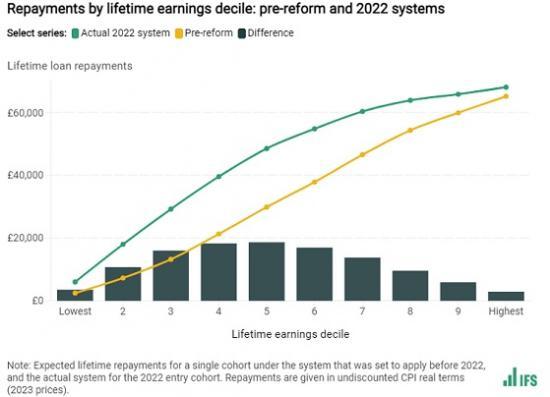Future Graduates Will Pay More In Student Loan Repayments - And The Poorest Will Be Worst Affected
25th February 2024

Lots of people are hoping to see a tax cut in their payslips after the British government announces its annual budget in March. The prime minister, Rishi Sunak, has said he wants to reduce the tax burden on workers, at a time when the country is paying more of the money it makes to the Treasury than at any time since the second world war.
But in all the discussion about tax cuts, what's rarely talked about is the fact that last year the government made a change to student loan conditions that means millions of future graduates will get less money in their pay packets - and pay much more to the government over their lifetimes. What's more, this will affect mostly low and middle earners, while some of the highest earners will actually pay less.
In 2023, the government introduced the biggest reforms to the student loans system in England in over a decade, in order to increase the proportion of student loan debt that is eventually repaid.
Students starting university from August 2023 will have to make loan repayments for longer - 40 rather than 30 years. And they will start repaying when their salary reaches £25,000, rather than nearly £30,000 under the previous system.
How interest is charged has also changed. Previously, higher earners paid more interest, but now new borrowers will pay the same rate, which is linked to a measure of inflation (the rate at which prices go up).
Research from the Institute for Fiscal Studies estimates that 79% of new borrowers will repay their student loans in full, compared with just 49% of those who took out their loans before August 2023.
Good news for the government, which will get more money back. But some economists have described the reforms as "deeply regressive" for penalising poorer graduates.
One analysis estimates that low-to-middle earners could end up repaying on average around £30,000 more over their lifetimes due to the extended repayment period. Meanwhile, high earners could repay £20,000 less due to the lower interest rate and their ability to pay off their loans quicker.
Things are getting worse
Most students in England borrow from the Student Loans Company to cover the cost of tuition fees and receive a maintenance loan to use towards their living costs. They later repay loans by having a certain amount taken out of their wages every month, meaning they experience repayments like a tax.
And, like tax, the amount they pay is calculated based on what they earn above a certain threshold. If they don't earn enough, they don't have to pay.
The threshold at which repayments start used to rise every year in line with average earnings growth. But in 2021 it was frozen at £27,295.
My colleagues and I have estimated that the repayment threshold would have been £29,860 this year if the freeze had not been implemented. And so those with loans are paying a higher proportion of their income in repayments each month.
For students starting university from August 2023 things look even worse, because the repayment threshold has been reduced to £25,000 and frozen for at least the next three years. With the repayment period extended to 40 years, this means borrowers will be forced to repay even more of their income each year and could be repaying student loans into their sixties.
A government analysis reported that those with lower lifetime earnings would be the most negatively affected, including more women and people from ethnic minority groups.
Our new research, suggests that those who will have to make repayments under the new system who wouldn't have before, are more likely to be from marginalised groups or in precarious work.
The study, which has not yet been reviewed by other academics but released as part of UCL's Centre for Longitudinal Studies working paper series, used data from the Next Steps study which, since 2004, has followed the lives of over 16,000 people born in 1989-90 up to the present day. We focused on data collected in 2015-16, when participants were aged 25.
We found that compared with higher earners, those drawn in to making repayments under the new system were more likely to be from an ethnic minority or a more disadvantaged background, such as those previously eligible for free school meals. They were much more likely to work part time or have a temporary or zero-hours contract, and were also more likely to be in education while also working.
What can be done?
Some researchers have proposed a stepped repayment system, similar to tax thresholds. Low and middle earners would repay a lower proportion of their income (for instance 3%-7%), while high earners would repay at the maximum rate of 9%.
However, they also recommend introducing a higher interest rate on student loans, in order to support the aim of increasing the proportion of student loan debt that is eventually repaid. This would slow down the rate at which high earners pay off their student loans, and could even fund the re-introduction of means-tested maintenance grants for students from poorer backgrounds attending university.
Another option would be to raise the income repayment threshold, at least in line with inflation. The threshold exists to protect borrowers with no or low income. But, especially given the recent rise in the cost of living, it is unclear whether the reformed threshold is serving this purpose.
As they currently stand, the recent reforms mean that new graduates will be losing a higher proportion of their income than before and will be paying back loans for much longer.
Author
Charlotte Booth
Research Fellow in Quantitative Social Science, UCL
Note
This article is from The Conversation web site. To read it with links to more information go HERE
